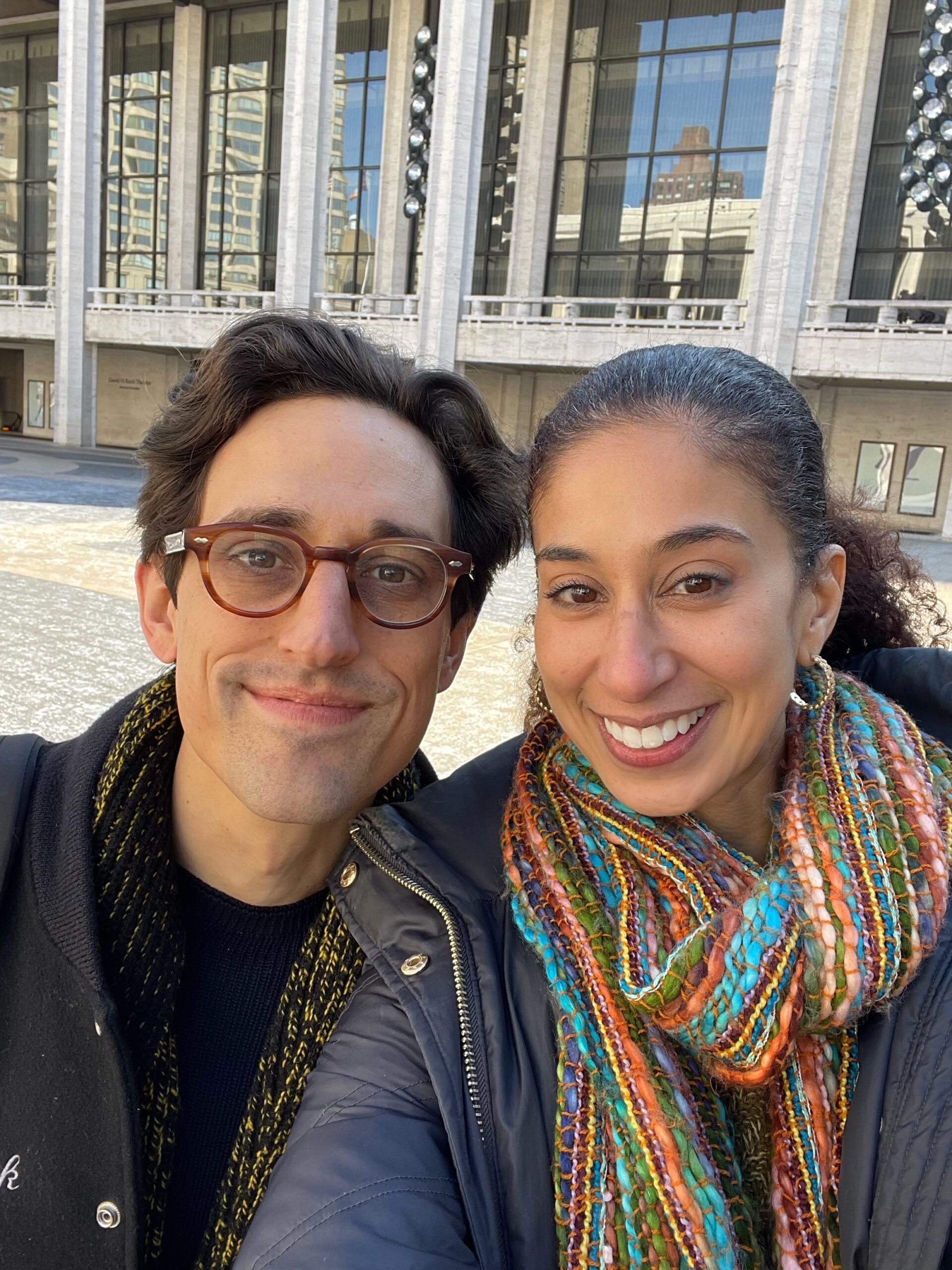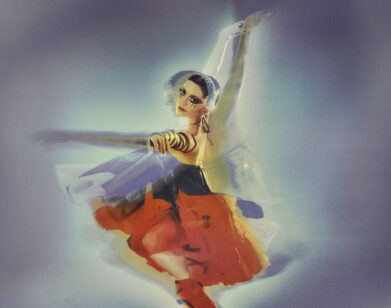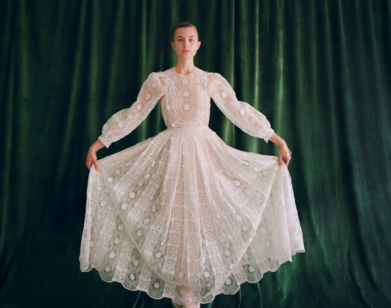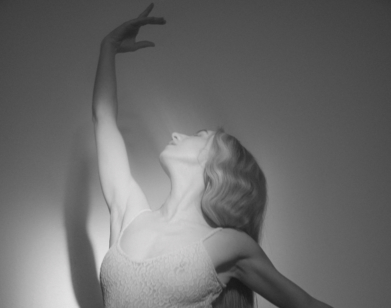ON POINTE
Justin Peck and Alicia Graf Mack Keep Juilliard’s Dancers on Their Toes
Alicia Graf Mack and Justin Peck are luminaries of the U.S. ballet world today. Both have statuesque physiques; in fact, had they danced in the same company, Peck, who is north of six feet tall, might have partnered Graf Mack, a commanding 5’10” (and well over six feet on pointe). At the New York City Ballet, Peck became a force as a choreographer before he was thirty, and his ballets are now in demand around the world. At her first company, Dance Theatre of Harlem, Graf Mack was recognized as one of the very finest Balanchine ballerinas of her time, in such roles as the Siren of Prodigal Son and the lead in Allegro Brillante. At the Alvin Ailey American Dance Theater, she proved to be a sensation in every role she took on.
Though neither artist studied at The Juilliard School, they are having a powerful effect there. Graf Mack, the first Dean and Director of the Dance Division to be appointed by Juilliard’s president Damian Woetzel, is also the first person of color and the youngest person ever to be named to that position. This year, Peck, a choreographer popular among the students, has been invited by Graf Mack to set his dances on Juilliard classes. Weeks before the opening of Juilliard’s Spring Dances, where students will perform Peck’s In Creases Peck and Graf Mack took five over Zoom to talk about diversifying the dance world, how to plié on a Peloton, what they do to unwind, and the ingredients of a classical pizza.
———
ALICIA GRAF MACK: Hey, Justin!
JUSTIN PECK: Hey, Alicia! What’s up? Are you guys on Spring break?
MACK: Yes, we have been on Spring Break for two weeks, but last week we hosted Ohad Naharin and dancers from Batsheva for a special workshop. The students stayed over their Spring Break to work with him for several hours at a time, and then they hosted a private audition on Saturday. So, we’ve been pretty busy. And you’re in rehearsal too, right?
PECK: I am. I don’t know how to describe it. It’s not exactly a musical, but it has music and dance and storytelling running through it. It’s a project I’ve been wanting to do for a decade. This week I’m doing the last missing pieces that I need to create a full draft. It’s about ninety minutes, no intermission. It’s not conventional. It’s sort of non-linear and jumps around a lot in terms of storytelling. We have a great group. We have one Juilliard alum who I worked with when I choreographed Become a Mountain [for Juilliard’s senior class of 2022], as well as one current student.
MACK: I can’t wait. Every time I’ve heard you talk about a new project, there are similar threads, that it’s looking at a new way of presenting dance and music and art, and there’s always some element of storytelling, even if it’s somewhat abstract. I think of you as the ultimate crossover king, utilizing all these different types of dance and movement and film and storytelling languages to get the idea across. I love that.
PECK: That’s something that you do as well, both as a dancer and also in the work you’re able to cultivate in a place like Juilliard. Is that something you think about?
MACK: I grew up dancing always. I started in a more modern dance-based school, always wanting to do ballet, though. And so I had such diverse environments for learning different movement styles. As I got older, I really concentrated on ballet; that was the path that I wanted to take. But the companies I worked for were both repertory companies, Dance Theatre of Harlem and Alvin Ailey American Dance Theater. And so working with those companies allowed me to try on many different types of movement languages, whether classical ballet or neoclassical ballet or contemporary work. I even did some hip-hop with Alvin Ailey and saw how rich my dance life was and how it provided longevity in my career. Seeing these dancers at Juilliard now, I would love them to have a taste of what it’s like to be able to sample the different types of incredible dance that there are in this world.
PECK: When did you begin there?
MACK: I began in the summer of 2018. And it’s interesting that you asked. I was trying to remember the first time that I met you in person. I had seen you dance for years. I frequented New York City Ballet while I was a member of Dance Theatre of Harlem, which is also a Balanchine-based company. And then, of course, as a fan, I knew of your work as a choreographer. When I started at Juilliard, I was also asked to perform at the Vail Dance Festival under Juilliard’s new president, Damian Woetzel [ed. artistic director of the Vail Festival since 2007]. I remember rehearsing with Carmen de Lavallade, who is a Kennedy Center honoree, a dance icon. And after our rehearsal ended, you came into the room and I was like, “What? That’s Justin Peck!”
PECK: It’s mutual though. I remember watching you a ton when you were at Ailey. You were still dancing there when Robert Battle took over. He started bringing in different repertory, too. That was super interesting to see the company explore. I remember seeing you in a bunch of that work as well, Petite Mort [by Jiří Kylián] and stuff.
MACK: Robert Battle is also a Juilliard alum, and now that I’m at Juilliard I have a better understanding of his artistic vision. He was a student there under the direction of Benjamin Harkarvy, who introduced a lot of Jiří Kylián and other European contemporary choreographers to the Juilliard students. It makes sense that, as the director of Alvin Ailey American Dance Theater, he would bring his dance lineage into the fold at Ailey.
PECK: You have a really exciting and also important platform where you commission choreographers and pair them up with each class. How do you think about that?
MACK: For our “New Dances” performances, we pair a different choreographer with each class of students, from the first through fourth years. I’m looking for someone who has a unique voice. I think it’s important for students to be in the room with choreographers who are open to allowing the dancers to understand their choreographic process. I’m looking for choreographers who are interested in challenging the dancers to think differently, to move differently, to dance differently, who see themselves not just as choreographers but have a love for education. In my first year at Juilliard, I sort of adopted a “New Dances” program that was curated by the interim artistic director. I saw that you were present in the audience and I thought that was so amazing that you would see a college-level program and be interested in supporting that program as an audience member. You were there at every other performance!
PECK: When I came in to make Become a Mountain, you said, “Just don’t worry too much about the product, focus on the process.” That was really helpful. And it’s true: that experience is about that exchange with the students. Also, a lot of the dancers I was working with were interested in dance composition of their own. We would spend time just having conversations and allowing space for them to ask questions; that was rewarding as well. When I am commissioned to make something at New York City Ballet or for another dance company or even a project that is for theater or film, it’s usually a more pressurized situation. At Juilliard, it didn’t feel like we were in a pressure cooker to get to the end quickly. We were able to take our time and try things. I was really proud of that work. And the students are everywhere, especially in the last few years, in terms of where they’ve been invited to dance, where they’ve been hired. They’re going in more diverse vectors, directions, under your guidance, too. Is that something you’ve thought about?
MACK: That was definitely intentional. When I first started at Juilliard, even from my interview process, I talked about how important equity, diversity, and inclusion are to our field. They provide a rich opportunity for the students. And this is also one of the key values of the Juilliard School under President Damian Woetzel. So it felt like the right fit. I think it’s so important to create a class or a cohort of students who are unique in every way, whether that is in terms of their race or their body type or the type of dancing that they connect with the most. I know you also share those same values. I’ve seen so many of your projects, your work with West Side Story. What are your philosophies on the types of dancers that you find exciting?
PECK: I completely agree. A diverse range of dancers with diverse backgrounds can be inspired by one another and learn from each other and grow collectively. That’s the best-case scenario. And it’s interesting to think about the outlook on the quote unquote, ballet body, too. A standard exists as to what is expected of a ballet dancer or a ballerina, which goes back sometimes hundreds of years. That’s been shifting a lot recently. Working in New York City Ballet, I’m mindful that the company needs to reflect the city in which it exists, and that’s a work in progress. It has a long, long way to go, but that’s definitely a huge goal and a serious goal in terms of how I can influence the company.
MACK: Being in the space with the choreographer who comes from a world unlike your own–Kyle Abraham or Jamar Roberts or Andrea Miller–opens the dancers’ worlds to see the possibilities of lots of different voices.
PECK: Do you still think of yourself as a dancer?
MACK: Absolutely. I’m not dancing as much anymore. I mostly dance on my Peloton in the morning, but I try to keep it in my practice here and there. I have the heart of a dancer. I’m someone who sees the world through the lens of dance. I look outside, I see the traffic patterns of the cars on the street, it’s choreographic. I see leaves blowing in the wind, that’s also choreographic. Or I see various day-to-day things, like a processional at a funeral, and I see dance. I see how humans tell stories through their body.
PECK: My favorite moment is walking in New York and seeing two people coming from opposite directions and then a third person coming from 90 degrees, and they all pass right at the same time.
MACK: Those types of things are very hard to rehearse in choreography authentically.
PECK: It happens more often than people realize. In New York, at least.
MACK: I want to pivot a second to this year’s “Spring Dances.” We were just talking about the diversity of the students and the directions in which they want to go. I’ve found in the last four years, more and more students at Juilliard really want to go into the ballet world upon graduation, which I find very exciting. Our students take ballet every day. They also take pointe and allégro, which traditionally has been called men’s class, but we have a more gender-fluid approach to our classical ballet training. And I thank you from the bottom of my heart for giving us this gift of In Creases. It has allowed the dancers to grow in their confidence about their artistic skills. The work is very complex, fast as lightning; it requires very sophisticated partnering and pointe work, and they are ready. They have been working so hard with your wife, Patricia Delgado, who’s also a faculty member at Juilliard, and they’ve approached it from the beginning with such a great sense of joy. I think her spirit really helps to bring that to the table every day. I was just thinking about one of the conversations that we had around costuming tights and shoes, because our cast is so diverse. For our cast, who have so many different beautiful skin tones, you said, “Well, let’s make sure that those skin tones are represented.”
PECK: In Creases is one of my earliest commissioned works for New York City Ballet, and it’s one that I always love to return to. There’s a purity to it, a clarity and precision. I think of it as an ensemble of soloists because everyone really takes their moment to step out of the group and it doesn’t happen in an overt way. You almost don’t realize that someone new has emerged. It’s a dancer’s work. Is it the first “Spring Dances” work on pointe?
MACK: It’s a rarity. In my time, the dancers have not performed on pointe on the Peter Jay Sharp Theater stage, but they have when they choreographed on themselves. In this class who’s graduating, there are seniors who, from the day that they started at Juilliard, have asked, “When are you bringing up a pointe work piece?” Actually, I heard from Patricia that on the last day before they had Spring Break, they all sat down together and had an open discussion, kind of a debriefing, if you will. Many commented on how afraid they were at first to approach the work but how they feel they’ve grown infinitely through the process. It’s fast, and you’ve got to get [right] up on that pointe shoe or else it’s just not going to happen. There’s no room to question. You just have to throw yourself into the movement and take the risk. That’s a huge lesson for them. I want to ask you, Justin, thinking about when you first started dancing at eight or nine years old, could you have imagined this life as a choreographer, director, creative person?
PECK: No. At that point, I didn’t even understand what making dance was. I actually found dance through a show in New York called Bring in ‘da Noise, Bring in ‘da Funk, which was George C. Wolfe’s and Savion Glover’s collaboration. I saw it when I was nine years old. And I was like, “What is this?” It was sort of mind-blowing, and I didn’t fully understand the whole thing, but I felt that something deep was being communicated through a certain form, a kind of dance that’s also about being your own musician. I’m only realizing now, in the last few years, that influence of tap dance on my own musicality. I’m thought of as this quote unquote ballet choreographer, but I’ve always felt on the outside of it. My experiences were in theater and other forms of dance. As I started to make my own work, I brought all these other experiences in: That’s been a big part of shaping my own voice. You danced with Dance Theatre of Harlem and then Ailey and then in LINES, right?
MACK: Yes, and I also danced with Complexions, Desmond Richardson and Dwight Rhoden’s contemporary ballet company. I performed with LINES when there was an injury. It was really interesting to work with Alonzo King, because he’s like a dance philosopher, right? He brings life into every step as poetry and philosophy.
PECK: What motivated you to change companies? That kind of decision comes with a certain amount of risk.
MACK: I don’t know that there was much thinking involved. I grew up wanting to be a ballerina. I met Arthur Mitchell at 17, and he took me into the company in my senior year of high school. That was quite an education, my first four years at Dance Theatre of Harlem, working under him and with all of these dancers or stagers from the Balanchine Trust. I performed in The Four Temperaments and Apollo and Allegro Brillante, so many wonderful works, but Arthur Mitchell also encouraged us to move as people, and I think that helped to continue my trajectory. I landed with Complexions in a crazy way. I was telling people, “I’m retired.” I went to Columbia University, I was working on Wall Street, I was trying to do something different, and I contacted Desmond and Dwight right after I graduated and said, “Hey, I’ve been working in marketing. Do you all need a marketing intern?” And they said, “Well, we’ve heard that you’ve been taking classes and you look amazing, and we need somebody to fill in because they’re injured and we have a tour across Italy this summer.” And I was like, “I’ll try.” I credit them for seeing something in me, for saying “I think you’re ready. I think you could try to do this again.” And the bug just bit me. I went back to Dance Theatre of Harlem, and then the company closed. So there were some 40 Black ballet dancers out of work in May of 2004. I freelanced for a year. I reached out to various companies. I wanted to stay in New York. I had wanted to dance for Ailey since I was little. I used to watch videotapes until they warped of Donna Wood performing Cry or Revelations. So it was more about the want to do it, the aspiration, more than switching styles.
PECK: I remember seeing Ailey on tour when I was a kid, and that was another really inspiring moment, seeing Revelations. And what’s that section with the dynamic men’s trio? Is it “Sinner Man”?
MACK: “Sinner Man,” yes.
PECK: And I was just like, “Whoa! These guys, moving that way!”
MACK: Absolutely. Now I’m curious to know what you do with any free time or what you do to unwind from work.
PECK: We have an almost-two-year-old. Just having that kind of family life balance, having to, in the best way, step away from stuff and just be in that kind of simple phase, helps me unwind. Although it has its own challenges, too. So I don’t get a whole lot of time off or anything like that. But one of my moments of peace and breath, just a mood lifter, is that I commute. I’ve been an avid bicycle commuter since I was in my early twenties in New York. I don’t want to get in a car. I don’t want to get in the subway. I want to just be outside. And it’s gotten to such an extent that, even when it’s freezing, I just layer and I bike.
MACK: Wow.
PECK: Also, you can’t be on your phone. You can’t really be listening to anything. You just have to be in your own thoughts.
MACK: I know that you also have one more talent though, because I was following you over the pandemic. You were making these epic pizzas! I’m coming over one day. I need to experience that for myself.
PECK: Yeah, it was Patricia’s fortieth birthday. She’s a homebody, and her idea of the best time is to have friends over and just hang out. We had people over and I baked eleven pizzas. It was like a pizza restaurant. A buddy of mine was my sous-chef assistant, and we just churned them out all night.
MACK: What’s the signature pizza?
PECK: I’m more of a classicist. I have a great sort of tweaked homemade dough. Everything’s homemade. I have a tomato sauce that I make from scratch, and then the dough, and then it’s just getting the best ingredients to put on. Every pizza was different. That’s another unwinding thing, the mundane, just cooking and chopping vegetables, finding those simple acts to balance out all the broader, more complicated things.
MACK: Nice.
PECK: Should we end there, with pizza?




